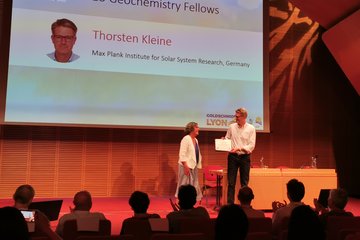Alle Typen
1.
Zeitschriftenartikel
The properties of Titan's surface at the Huygens landing site from DISR observations. Planetary and Space Science 56, S. 728 - 752 (2008)
2.
Zeitschriftenartikel
Coupling Planet Simulator Mars, a general circulation model of the Martian atmosphere, to the ice sheet model SICOPOLIS. Planetary and Space Science 55, S. 2087 - 2096 (2007)
3.
Zeitschriftenartikel
The planetary fourier spectrometer (PFS) onboard the European Venus Express mission. Planetary and Space Science 54 (13-14), S. 1298 - 1314 (2006)
4.
Zeitschriftenartikel
Shading under Titan's sky. Planetary and Space Science 53 (5), S. 577 - 585 (2005)
5.
Zeitschriftenartikel
Response of the intermediate complexity Mars} {Climate} {Simulator to different obliquity angles. Planetary and Space Science 53 (6), S. 659 - 670 (2005)
6.
Zeitschriftenartikel
Rain, winds and haze during Huygens probe's descent to Titan's surface. Nature 438, S. 765 - 778 (2005)
7.
Zeitschriftenartikel
Evolution of the north-polar cap of Mars: A modelling study. Planetary and Space Science 52 (9), S. 775 - 787 (2004)
8.
Zeitschriftenartikel
Simulating Titan's tropospheric circulation with the Portable University Model of the Atmosphere. Advances in Space Research 34 (8), S. 1650 - 1654 (2004)
9.
Zeitschriftenartikel
Sea surface temperature anomalies in the oceans at the LGM estimated from the alkenone-UK'37} index: comparison with {GCMs. Geophysical Research Letters 31 (3), L03208 (2004)
10.
Zeitschriftenartikel
Book Review on ``Expedition Mars'', by Martin L. J. Turner. Earth, Moon and Planets 93, S. 234 (2003)
11.
Zeitschriftenartikel
Inverse radiation modeling of Titan's atmoshere to assimilate Solar Aureole Imager data of the Huygens probe. Planetary and Space Science 51, S. 147 - 158 (2003)
12.
Zeitschriftenartikel
Glacial South-Atlantic surface temperatures interpolated with a semi-inverse ocean model. Paleoceanography 18 (3), 1056 (2003)
13.
Zeitschriftenartikel
Simultaneous retrieval of optical depths and scattering phase functions in Titan's atmosphere from Huygens/DISR data. Planetary and Space Science 51, S. 991 - 1001 (2003)
14.
Zeitschriftenartikel
A spherical model for computing polarized radiation in Titan's atmosphere. Planetary and Space Science 51, S. 977 - 989 (2003)
15.
Zeitschriftenartikel
Assimilation of data from the Solar Aureole imager and the Visible Spectrometer onboard the Huygens probe into a radiative transfer model of Titan's atmosphere. Bulletin of the American Astronomical Society 33, S. 1140 (2001)
16.
Buchkapitel
Inverse Modelling of the Glacial Atlantic Circulation under Geostrophic Side Conditions. In: The South Atlantic in the Late Quaternary: Reconstruction of Material Budgets and Current Systems, S. 585 - 599 (Hg. Wefer, G.; Mulitza, S.; Ratmeyer, V.). Springer-Verlag, Berlin, Heidelberg, New York, Tokyo (2003)
17.
Buchkapitel
Interpolating paleovegetation data with an artificial neural network approach. In: From Process Studies to Reconstruction of the Palaeoenvironment: Advances in Palaeoceanography and Climatology, S. 199 - 208 (Hg. Ganssen, G.). Elsevier, Amsterdam (2002)
18.
Konferenzbeitrag
A multi-disciplinary investigation of the Jovian system. In: Proceedings of the 39th ESLAB Symposium, Trends in Space Science and Cosmic Vision 2020, S. 225 - 231 (Hg. Favata, F.; Sanz-Forcada, J.; Gimenez, A.). ESA Publ. Div., Noordwijk (2005)
19.
Konferenzbeitrag
Indication of a near surface cloud layer on Venus} from reanalysis of Venera 13/14 spectrophotometer data. In: Proc. Int. Workshop `Planetary Probe Atmospheric Entry and Descent Trajectory Analysis and Science', S. 63 - 70. ESA Publ. Div., Noordwijk (2004)











